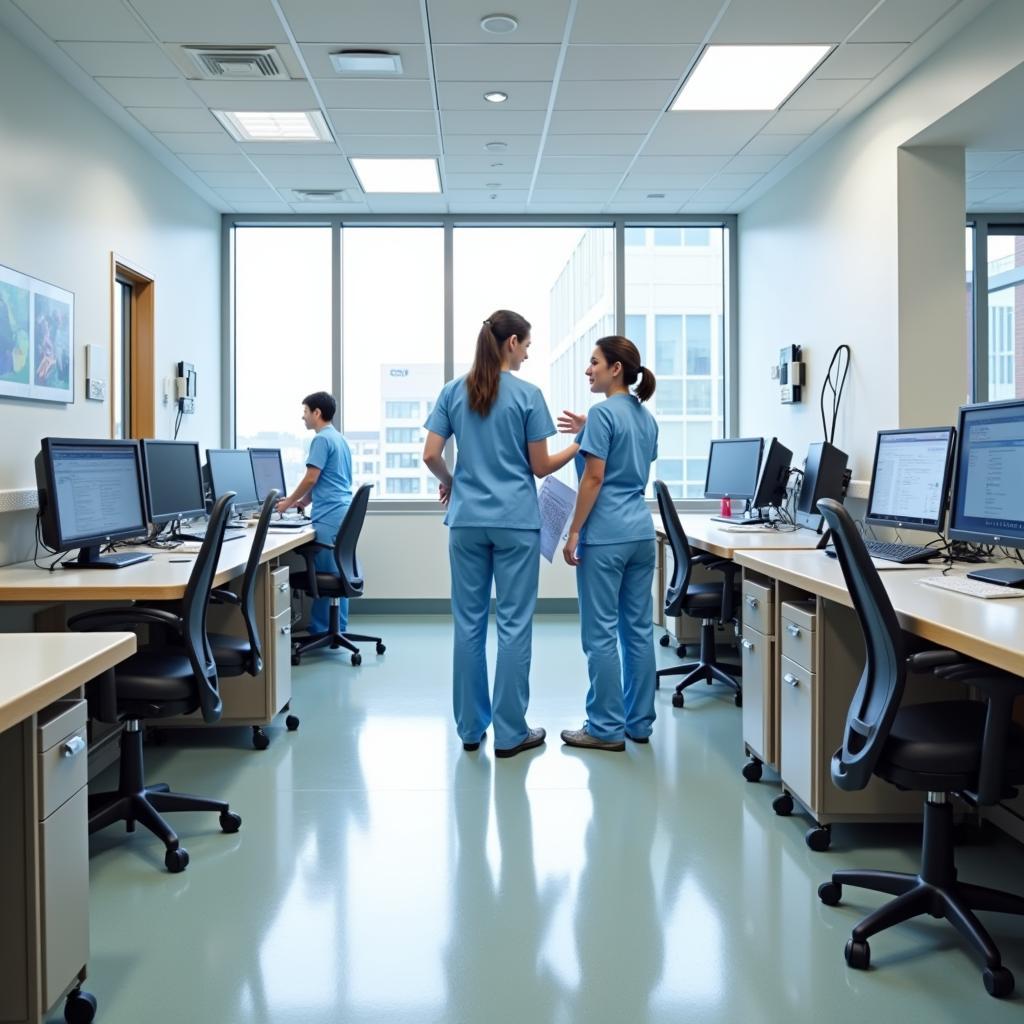The Nursing Station Hospital: a hive of activity, a hub of information, and the heart of patient care. This critical area within a hospital serves as the central command center for nurses, fostering collaboration and ensuring efficient, high-quality care for every patient. But what exactly makes a nursing station tick? Let’s delve into the intricacies of this essential hospital component and explore its evolution in the digital age.
The Anatomy of an Efficient Nursing Station
A well-designed nursing station is more than just a desk; it’s a carefully planned workspace that maximizes efficiency and promotes seamless communication. Here’s a closer look at the key elements:
- Ergonomics: Comfortable seating, adjustable-height workstations, and strategically placed computer screens minimize strain and fatigue for nurses working long shifts.
- Visibility: A clear line of sight to patient rooms allows nurses to monitor patients discreetly and respond quickly to call lights or requests for assistance.
- Technology Integration: From electronic health records (EHR) and medication dispensing systems to communication devices and patient monitoring systems, technology is seamlessly integrated into the nursing station to streamline workflows and enhance patient safety.
- Collaboration Zones: Dedicated spaces for team huddles, physician consultations, and shift changes facilitate communication and foster a collaborative care environment.
 Modern Nursing Station Design
Modern Nursing Station Design
The Evolving Role of the Nursing Station in the Digital Age
Technology has revolutionized healthcare, and the nursing station is at the forefront of this transformation. Here’s how:
- Enhanced Communication: Real-time messaging systems, wireless headsets, and mobile devices enable instant communication between nurses, physicians, and other members of the care team, reducing delays and improving care coordination.
- Data-Driven Insights: Electronic health records provide a comprehensive view of patient data, empowering nurses to make informed decisions and personalize care plans.
- Improved Patient Safety: Automated medication dispensing systems, smart infusion pumps, and bedside monitoring systems enhance patient safety by minimizing medication errors and providing real-time alerts for potential complications.
Beyond Functionality: Creating a Welcoming and Patient-Centered Space
While efficiency and technology are paramount, a well-designed nursing station also prioritizes the patient experience. Consider these aspects:
- Noise Reduction: Sound-absorbing materials, strategic furniture placement, and designated quiet zones help minimize noise levels, promoting a calm and healing environment.
- Natural Light and Aesthetics: Incorporating natural light, calming colors, and natural elements creates a welcoming and less clinical atmosphere.
- Privacy and Confidentiality: Designated consultation areas and private workspaces ensure patient privacy and confidentiality during discussions and charting.
 Patient-Centered Nursing Station
Patient-Centered Nursing Station
FAQs: Addressing Common Questions about Nursing Station Hospitals
1. What is the primary purpose of a nursing station in a hospital?
The nursing station acts as a central hub for coordinating patient care. Nurses use this space to access patient records, communicate with the medical team, prepare medications, and monitor patient well-being.
2. How has technology impacted the design and function of nursing stations?
Technology has led to more ergonomic designs that seamlessly integrate computers, monitors, and communication devices. This integration streamlines workflows, reduces errors, and allows for more proactive and data-driven patient care.
3. How can hospitals ensure patient privacy is maintained at nursing stations?
Hospitals implement various strategies, including using privacy screens, lowering voices when discussing patient information, and adhering to HIPAA regulations for handling electronic health records. Designated consultation areas also provide a private space for conversations.
The Nursing Station: An Enduring Symbol of Care and Collaboration
The nursing station hospital remains an essential element of healthcare delivery, evolving to meet the demands of modern medicine. By embracing technology, prioritizing ergonomics, and creating a patient-centered environment, hospitals can ensure this critical space continues to foster collaboration, efficiency, and exceptional patient care.
For inquiries about our services and commitment to patient well-being, contact San Jose Hospital at Phone Number: 02437655121, Email: irccsanjose@gmail.com Or visit us at: Số 298 Đ. Cầu Diễn, Minh Khai, Bắc Từ Liêm, Hà Nội, Việt Nam. Our dedicated team is available 24/7 to assist you.
 using WordPress and
using WordPress and